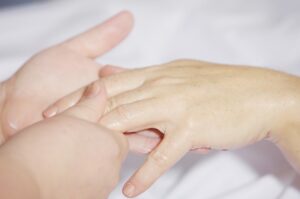Jammed Finger or Finger Sprain

A jammed finger or finger sprain is a common hand injury that occurs when the ligaments that support the proximal interphalangeal (PIP) joint, which is the second joint from the tip of the finger, become stretched or torn. This injury can be caused by a sudden impact, such as a fall or a sports injury, or by overuse, such as repetitive gripping or typing. In this paper, we will discuss the causes, symptoms, and treatment options for PIP joint sprains.
Causes of a Jammed Finger
The PIP joint is surrounded by ligaments that provide stability to the joint. When these ligaments are stretched or torn, a PIP joint sprain occurs. This injury can be caused by a variety of factors, including:
Direct impact: A sudden impact to the finger, such as a fall or a sports injury, can cause the ligaments to stretch or tear.
Overuse: Repetitive gripping or typing can cause the ligaments to become overstretched, leading to a PIP joint sprain.
Arthritis: Arthritis can weaken the ligaments around the PIP joint, making them more susceptible to injury.
Symptoms of a Jammed Finger
The symptoms of a PIP joint sprain can vary depending on the severity of the injury. Common symptoms include:
Pain: Pain around the PIP joint is the most common symptom of a sprain.
Swelling: The joint may become swollen and tender to the touch.
Stiffness: The joint may feel stiff and difficult to move.
Bruising: Bruising around the joint may occur.
Deformity: In severe cases, the joint may become deformed or dislocated.
Treatment for Jammed Finger
The treatment for a PIP joint sprain will depend on the severity of the injury. Mild sprains can often be treated with rest and self-care, while more severe sprains may require medical attention.
Rest: Resting the affected hand and avoiding activities that cause pain or discomfort is important to allow the ligaments to heal.
Ice: Applying ice to the affected area can help reduce swelling and pain.
Compression: Wrapping the affected finger with a compression bandage can help reduce swelling and provide support to the joint.
Elevation: Elevating the affected hand can help reduce swelling and promote healing.
Immobilization: In severe cases, a splint or cast may be necessary to immobilize the joint and allow it to heal.
Physical therapy: Once the ligaments have healed, physical therapy may be recommended to help restore strength and range of motion to the affected finger.
Surgery: In rare cases, surgery may be necessary to repair torn ligaments or realign the joint.
Conclusion
A PIP joint sprain can be a painful and debilitating injury. However, with proper treatment and care, most people are able to recover fully and regain full use of their hand. If you suspect that you have a PIP joint sprain, it is important to seek medical attention to determine the extent of the injury and receive appropriate treatment.
Click Here for More Information.
